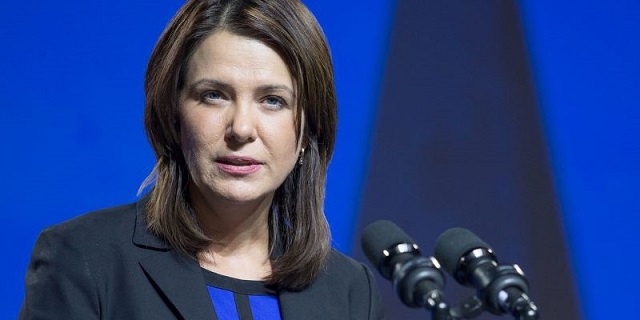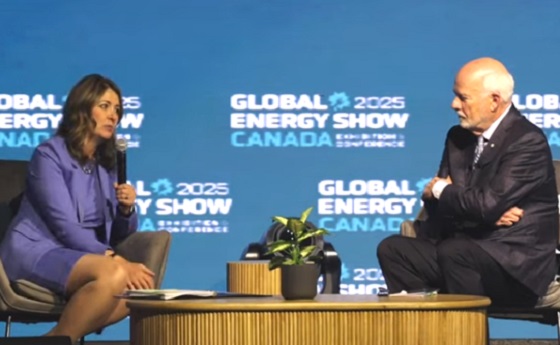Alberta
Premier Smith hammers Liberal government for ‘slightly’ reducing immigration

As so often happens these days the headlines from major news outlets all look like they were written by the same people. All the major news outlets repeated the government talking point that immigration would be reduced significantly. In his news release, Immigration Minister Marc Miller spoke of “controlled targets” and even “marginal” declines in Canada’s population. Minister Miller made it sound like the feds are pulling way back on the number of immigrants being allowed into the country.
A few hours later, Premier Danielle Smith explained how Alberta sees things. According to Premier Smith, immigrants will still be pouring into the country at near record levels. Smith says this new immigration plan will offer almost no relief whatsoever to provinces buckling under the pressure of so many newcomers.
Premier Smith is right. When you take out all the adjectives and the self back-patting, the 2025 – 2027 Immigration Levels Plan shows the number of new immigrants will still hover near record levels.
From the 2025–2027 Immigration Levels Plan.
The levels plan includes controlled targets for temporary residents, specifically international students and foreign workers, as well as for permanent residents.
We are:
- reducing from 500,000 permanent residents to 395,000 in 2025
- reducing from 500,000 permanent residents to 380,000 in 2026
- setting a target of 365,000 permanent residents in 2027
Quick facts:
- Canada’s population has grown in recent years, reaching 41 million in April 2024. Immigration accounted for almost 98% of this growth in 2023, 60% of which can be attributed to temporary residents.
- Francophone immigration will represent
- 8.5% in 2025
- 9.5% in 2026
- 10% in 2027
The Levels Plan also supports efforts to reduce temporary resident volumes to 5% of Canada’s population by the end of 2026. Canada’s temporary population will decrease over the next few years as significantly more temporary residents will transition to being permanent residents or leave Canada compared to new ones arriving. Specifically, compared to each previous year, we will see Canada’s temporary population decline by
- 445,901 in 2025
- 445,662 in 2026
- a modest increase of 17,439 in 2027
It’s interesting how the feds explain the situation with “temporary residents”. This group includes foreign students and temporary workers. Most Canadians would probably be shocked to know just how many people are “temporarily” here.
Minister Miller says this population will decline by 445,901 people in 2025. What he leaves out is that this still allows for just over 2,000,000 foreign students and temporary workers! (5% of 41,000,000 Canadians is 2,050,000)
It’s also very interesting that in the explanation for how the feds plan to cut the number of temporary residents down from about 2.6 million to just over 2 million, is by recognizing that many of the temporary residents will transition to being permanent residents. It’s not clear how that will reduce the number of people in the country. I guess we’ll have to see how that all turns out.
Meanwhile Alberta Premier Danelle Smith and Minister of Immigration and Multiculturalism Muhammad Yaseen issued this joint statement on today’s federal government immigration announcement:
“Alberta has a long history of welcoming newcomers, and we plan to maintain that reputation.
“However, the federal government’s reckless and irresponsible open-border immigration policies, permitting almost 2 million newcomers to enter Canada last year alone, have led to unsustainable financial pressures on all provinces.
“With the cost of food, energy, housing and everything else in this country increasing, and with tens of thousands of new people moving to Alberta monthly, our hospitals and schools are at or above capacity.
“As a province, we need a reprieve from this explosive population growth so we can catch up with these pressures. So do all provinces.
“The federal government’s plan to cut a mere 105,000 new permanent residents will not solve these pressures when they are bringing in almost 2 million additional people annually.
“We call on the government to cut the number of newcomers to Canada from almost 2 million to well under 500,000 annually until further notice.
“Ottawa’s priority should be on reducing the number of temporary foreign workers, international students and asylum seekers—not on reducing provincially selected economic migrants.”
Alberta
Alberta’s grand bargain with Canada includes a new pipeline to Prince Rupert

From Resource Now
Alberta renews call for West Coast oil pipeline amid shifting federal, geopolitical dynamics.
Just six months ago, talk of resurrecting some version of the Northern Gateway pipeline would have been unthinkable. But with the election of Donald Trump in the U.S. and Mark Carney in Canada, it’s now thinkable.
In fact, Alberta Premier Danielle Smith seems to be making Northern Gateway 2.0 a top priority and a condition for Alberta staying within the Canadian confederation and supporting Mark Carney’s vision of making Canada an Energy superpower. Thanks to Donald Trump threatening Canadian sovereignty and its economy, there has been a noticeable zeitgeist shift in Canada. There is growing support for the idea of leveraging Canada’s natural resources and diversifying export markets to make it less vulnerable to an unpredictable southern neighbour.
“I think the world has changed dramatically since Donald Trump got elected in November,” Smith said at a keynote address Wednesday at the Global Energy Show Canada in Calgary. “I think that’s changed the national conversation.” Smith said she has been encouraged by the tack Carney has taken since being elected Prime Minister, and hopes to see real action from Ottawa in the coming months to address what Smith said is serious encumbrances to Alberta’s oil sector, including Bill C-69, an oil and gas emissions cap and a West Coast tanker oil ban. “I’m going to give him some time to work with us and I’m going to be optimistic,” Smith said. Removing the West Coast moratorium on oil tankers would be the first step needed to building a new oil pipeline line from Alberta to Prince Rupert. “We cannot build a pipeline to the west coast if there is a tanker ban,” Smith said. The next step would be getting First Nations on board. “Indigenous peoples have been shut out of the energy economy for generations, and we are now putting them at the heart of it,” Smith said.
Alberta currently produces about 4.3 million barrels of oil per day. Had the Northern Gateway, Keystone XL and Energy East pipelines been built, Alberta could now be producing and exporting an additional 2.5 million barrels of oil per day. The original Northern Gateway Pipeline — killed outright by the Justin Trudeau government — would have terminated in Kitimat. Smith is now talking about a pipeline that would terminate in Prince Rupert. This may obviate some of the concerns that Kitimat posed with oil tankers negotiating Douglas Channel, and their potential impacts on the marine environment.
One of the biggest hurdles to a pipeline to Prince Rupert may be B.C. Premier David Eby. The B.C. NDP government has a history of opposing oil pipelines with tooth and nail. Asked in a fireside chat by Peter Mansbridge how she would get around the B.C. problem, Smith confidently said: “I’ll convince David Eby.”
“I’m sensitive to the issues that were raised before,” she added. One of those concerns was emissions. But the Alberta government and oil industry has struck a grand bargain with Ottawa: pipelines for emissions abatement through carbon capture and storage.
The industry and government propose multi-billion investments in CCUS. The Pathways Alliance project alone represents an investment of $10 to $20 billion. Smith noted that there is no economic value in pumping CO2 underground. It only becomes economically viable if the tradeoff is greater production and export capacity for Alberta oil. “If you couple it with a million-barrel-per-day pipeline, well that allows you $20 billion worth of revenue year after year,” she said. “All of a sudden a $20 billion cost to have to decarbonize, it looks a lot more attractive when you have a new source of revenue.” When asked about the Prince Rupert pipeline proposal, Eby has responded that there is currently no proponent, and that it is therefore a bridge to cross when there is actually a proposal. “I think what I’ve heard Premier Eby say is that there is no project and no proponent,” Smith said. “Well, that’s my job. There will be soon. “We’re working very hard on being able to get industry players to realize this time may be different.” “We’re working on getting a proponent and route.”
At a number of sessions during the conference, Mansbridge has repeatedly asked speakers about the Alberta secession movement, and whether it might scare off investment capital. Alberta has been using the threat of secession as a threat if Ottawa does not address some of the province’s long-standing grievances. Smith said she hopes Carney takes it seriously. “I hope the prime minister doesn’t want to test it,” Smith said during a scrum with reporters. “I take it seriously. I have never seen separatist sentiment be as high as it is now. “I’ve also seen it dissipate when Ottawa addresses the concerns Alberta has.” She added that, if Carney wants a true nation-building project to fast-track, she can’t think of a better one than a new West Coast pipeline. “I can’t imagine that there will be another project on the national list that will generate as much revenue, as much GDP, as many high paying jobs as a bitumen pipeline to the coast.”
Alberta
Alberta Premier Danielle Smith Discusses Moving Energy Forward at the Global Energy Show in Calgary

From Energy Now
At the energy conference in Calgary, Alberta Premier Danielle Smith pressed the case for building infrastructure to move provincial products to international markets, via a transportation and energy corridor to British Columbia.
“The anchor tenant for this corridor must be a 42-inch pipeline, moving one million incremental barrels of oil to those global markets. And we can’t stop there,” she told the audience.
The premier reiterated her support for new pipelines north to Grays Bay in Nunavut, east to Churchill, Man., and potentially a new version of Energy East.
The discussion comes as Prime Minister Mark Carney and his government are assembling a list of major projects of national interest to fast-track for approval.
Carney has also pledged to establish a major project review office that would issue decisions within two years, instead of five.
-

 conflict2 days ago
conflict2 days agoOne dead, over 60 injured after Iranian missiles pierce Iron Dome
-

 Crime13 hours ago
Crime13 hours agoManhunt on for suspect in shooting deaths of Minnesota House speaker, husband
-

 Business3 hours ago
Business3 hours agoCarney’s European pivot could quietly reshape Canada’s sovereignty
-

 Alberta2 hours ago
Alberta2 hours agoAlberta’s grand bargain with Canada includes a new pipeline to Prince Rupert



